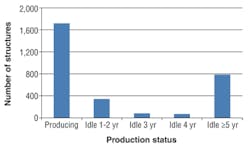The business side of offshore geology and geophysics in 2009 remained in tune with the generally weak year for the entire E&P industry. As the global survey of seismic vessel activity in this month’s issue shows, the vessel count was 156, down by 17 from last year’s report.
New vessels are hitting the market in 2010. Fairfield has theCarolyn Chouest, Fugro Services Ltd. adds the Fugro Searcher, PGS adds the PGS Apollo, and Polarcus expects the Nalia, Samur, Selma, Asima, and Alima.
More details and the complete listing byGene Kliewer, Technology Editor, Seismic & Subsea, begin on page 32.
Subsea separation, boosting reach record depths
As the offshore oil industry reaches deeper and more challenging waters, the benefits of subsea processing technology are proving technically and economically viable. Recent awards and start-ups indicate several new projects in the developmental stages plus new world records for installed systems.
Subsea separation and boosting technology is now operational in 2,438 m (7,999 ft) water depth in Shell’s Perdido field. Perdido’s use of multiple subsea separation and boosting stations highlights one option for the future of offshore oil production.
In this month’s issue,Michael Padilla and Matt Reznicek of INTECSEA take a look at the growing importance and viability of subsea processing in developing offshore fields. Their analysis begins on page 58. And don’t miss the wall-size subsea processing poster included in this issue.
Port Fourchon thrives on deepwater activity
With the deepwater Gulf of Mexico as its backyard, Port Fourchon, Louisiana, is the nucleus for nearly all of the flourishing drilling and production business in the outer fringes of the US continental shelf. Port Fourchon also serves as the base for the Louisiana Offshore Oil Port (LOOP) that offloads from some of the world’s largest tankers as much as 1.2 MMb/d, or 10-15% of all US oil imports.
The core of Port Fourchon remains the deepwater. The US Minerals Management Service (MMS) said that as of Jan. 25, 43 new projects in 1,030 ft to 8,850 ft (314 to 2,697 m) of water were undergoing either drilling or workover operations. Factoring in the 135 deepwater fields already developed, there are nearly 230 deep and ultra deepwater projects in need of products and services, not including the projects under way this year. Read this issue’s special report beginning onpage 67.
Caspian Sea set for offshore resurgence
The Caspian offshore is one of the world’s most important sources of oil and gas production growth. In 2010, offshore production is expected to top 1.5 MMboe/d, with plans in place to reach 3 MMboe/d by 2020, according to estimates by energy analysts Wood Mackenzie.
Three giant offshore fields – Azeri-Chirag-Guneshli (ACG), Shah Deniz, and Kashagan – account for the majority of oil and gas investment, and about two-thirds of remaining reserves. New pipelines will unlock reserves in the giant fields while acting as a catalyst for myriad smaller projects that will be ready for development over the next two decades.
Ian Thom of Wood Mackenzie gives a full report beginning on page 28.






